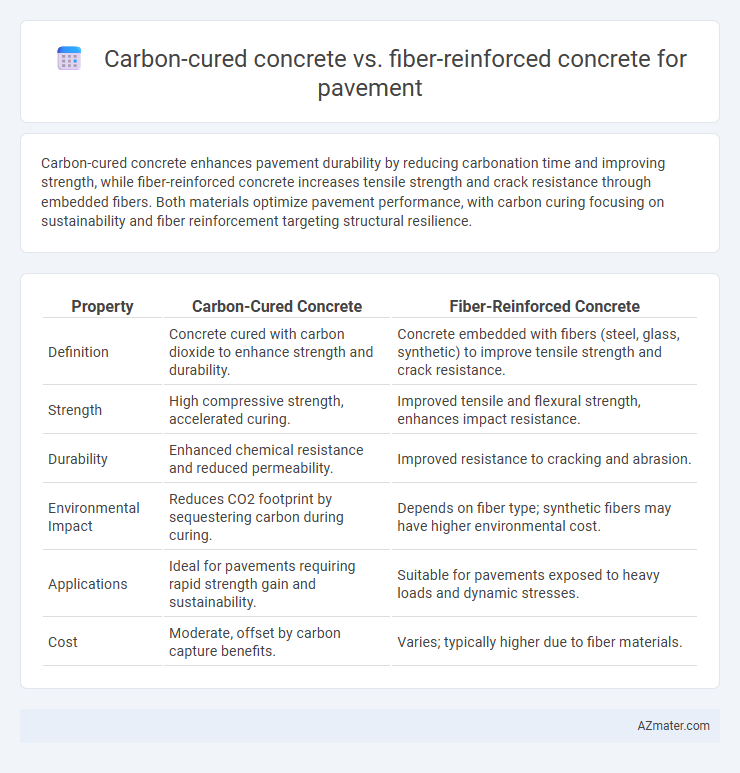Carbon-cured concrete enhances pavement durability by reducing carbonation time and improving strength, while fiber-reinforced concrete increases tensile strength and crack resistance through embedded fibers. Both materials optimize pavement performance, with carbon curing focusing on sustainability and fiber reinforcement targeting structural resilience.
Table of Comparison
| Property | Carbon-Cured Concrete | Fiber-Reinforced Concrete |
|---|---|---|
| Definition | Concrete cured with carbon dioxide to enhance strength and durability. | Concrete embedded with fibers (steel, glass, synthetic) to improve tensile strength and crack resistance. |
| Strength | High compressive strength, accelerated curing. | Improved tensile and flexural strength, enhances impact resistance. |
| Durability | Enhanced chemical resistance and reduced permeability. | Improved resistance to cracking and abrasion. |
| Environmental Impact | Reduces CO2 footprint by sequestering carbon during curing. | Depends on fiber type; synthetic fibers may have higher environmental cost. |
| Applications | Ideal for pavements requiring rapid strength gain and sustainability. | Suitable for pavements exposed to heavy loads and dynamic stresses. |
| Cost | Moderate, offset by carbon capture benefits. | Varies; typically higher due to fiber materials. |
Introduction to Modern Pavement Materials
Carbon-cured concrete enhances pavement durability by utilizing accelerated carbon dioxide curing processes that improve strength and reduce permeability, promoting sustainability through CO2 sequestration. Fiber-reinforced concrete incorporates synthetic or steel fibers to increase tensile strength, crack resistance, and impact durability, making it ideal for high-traffic pavements. Both materials represent advancements in modern pavement technology, optimizing performance, longevity, and environmental impact for infrastructure applications.
What is Carbon-Cured Concrete?
Carbon-cured concrete is a innovative material where carbon dioxide is injected during the curing process, enhancing strength development and reducing carbon footprint in pavement construction. This technology accelerates curing time by chemically binding CO2 within the concrete matrix, leading to improved durability and reduced porosity compared to conventional curing methods. In pavement applications, carbon-cured concrete offers sustainability benefits by utilizing captured CO2 while maintaining structural performance.
Understanding Fiber-Reinforced Concrete
Fiber-reinforced concrete (FRC) enhances pavement durability by incorporating discrete fibers such as steel, glass, or synthetic materials that improve tensile strength, crack resistance, and impact absorption. Compared to carbon-cured concrete, FRC demonstrates superior performance in controlling shrinkage cracks and increasing flexural toughness, making it ideal for high-traffic and load-intensive pavement applications. The fiber content, type, and aspect ratio critically influence the mechanical properties and longevity of FRC pavements, ensuring optimized structural integrity under repeated stress.
Carbon-Cured Concrete: Strengths and Limitations
Carbon-cured concrete for pavement offers enhanced durability and accelerated curing through carbon dioxide infusion, resulting in reduced carbon footprint and improved compressive strength compared to traditional methods. This technology allows for faster construction cycles and increased resistance to chemical attack and abrasion, making it suitable for high-traffic areas. However, carbon-cured concrete may face limitations such as higher initial costs, dependency on specialized equipment, and potential variability in CO2 curing efficacy under different environmental conditions.
Performance of Fiber-Reinforced Concrete in Pavements
Fiber-reinforced concrete (FRC) significantly enhances pavement durability by improving tensile strength and crack resistance compared to traditional mixes. Its incorporation of synthetic or steel fibers effectively reduces shrinkage cracking and increases load-bearing capacity, leading to extended service life under heavy traffic conditions. FRC's superior impact and fatigue resistance make it an optimal choice for critical infrastructure requiring robust performance and minimal maintenance.
Durability Comparison: Carbon-Cured vs Fiber-Reinforced Concrete
Carbon-cured concrete exhibits enhanced durability due to its accelerated carbonation process, resulting in increased surface hardness and improved resistance to chloride penetration, which is critical for pavement longevity. Fiber-reinforced concrete enhances crack resistance and toughness by distributing tensile stresses more evenly throughout the pavement, thereby reducing surface deterioration from freeze-thaw cycles and mechanical loading. Comparative studies indicate carbon-cured concrete excels in chemical resistance and surface densification, while fiber-reinforced concrete offers superior flexural strength and impact resistance, making material selection dependent on specific pavement performance requirements.
Sustainability and Environmental Impact
Carbon-cured concrete for pavement significantly reduces carbon emissions by capturing and storing CO2 during the curing process, lowering the overall carbon footprint compared to traditional methods. Fiber-reinforced concrete enhances pavement durability and lifespan through improved crack resistance and mechanical strength, reducing maintenance frequency and material consumption over time. Both materials contribute to sustainable infrastructure, but carbon-cured concrete offers a more direct environmental benefit by actively sequestering greenhouse gases.
Cost and Lifecycle Analysis
Carbon-cured concrete offers lower initial costs due to faster curing times and reduced energy consumption, while fiber-reinforced concrete typically incurs higher upfront expenses driven by material costs. Lifecycle analysis reveals carbon-cured concrete provides enhanced durability and reduced carbon emissions, resulting in decreased maintenance costs over time, whereas fiber-reinforced concrete excels in crack resistance and tensile strength, potentially extending pavement lifespan under heavy traffic conditions. Cost-benefit evaluation for pavement projects should consider long-term performance metrics, environmental impact, and maintenance frequency to optimize material selection.
Best Applications for Each Concrete Type
Carbon-cured concrete excels in pavement applications requiring rapid strength gain and enhanced durability in cold climates, making it ideal for airport runways and urban roads with heavy traffic loads. Fiber-reinforced concrete offers superior resistance to cracking and improved tensile strength, best suited for pavements exposed to dynamic loads, such as industrial floors and highways with high vehicle stress. Selecting between these depends on project-specific demands for early strength versus flexibility and crack control in pavement infrastructure.
Future Trends in Pavement Concrete Technologies
Carbon-cured concrete leverages carbon dioxide to enhance curing and reduce carbon footprint, positioning it as a sustainable alternative in pavement construction. Fiber-reinforced concrete integrates synthetic or steel fibers to improve tensile strength, durability, and crack resistance, extending pavement lifespan under heavy traffic loads. Future trends emphasize hybrid solutions combining carbon curing and fiber reinforcement to optimize environmental benefits and mechanical performance in pavement technologies.

Infographic: Carbon-cured concrete vs Fiber-reinforced concrete for Pavement
 azmater.com
azmater.com